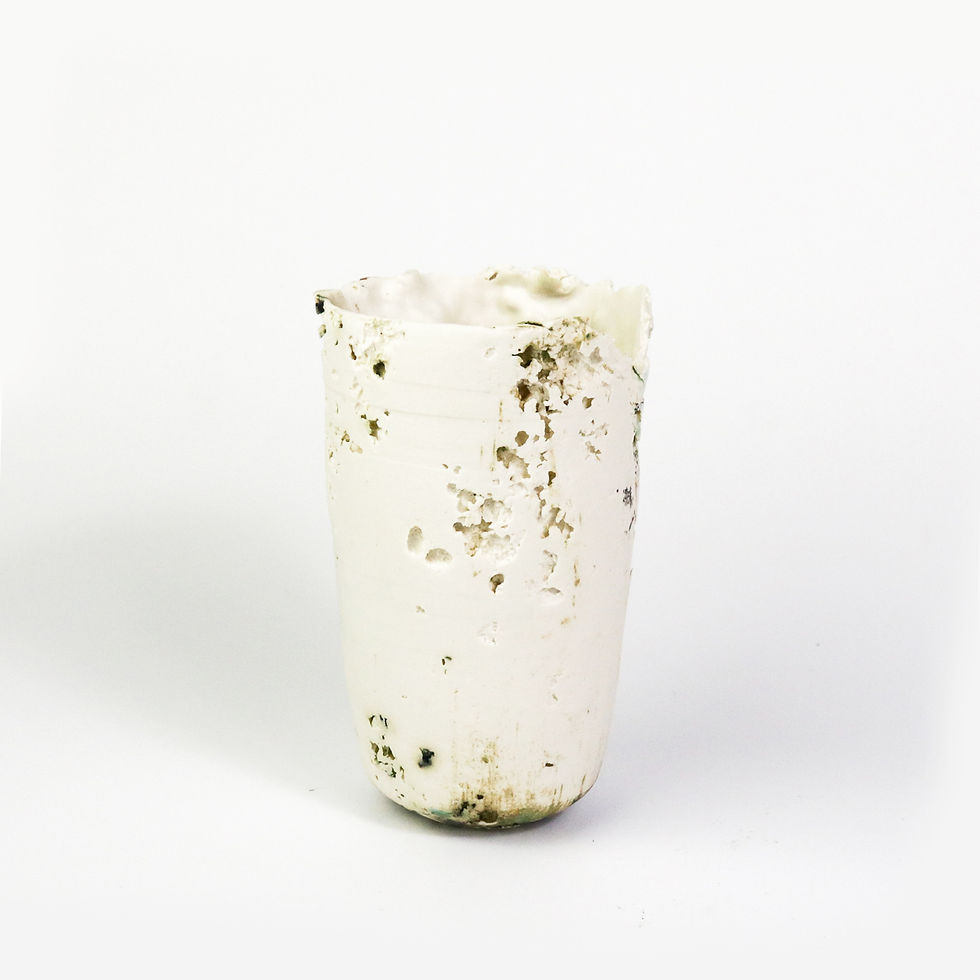We are proud to present an online solo collection for our 2023 New Designers Thrown Contemporary Ceramics Award winner, Sarah Coppard. This award is given to our pick from this entire national graduate showcase of the next notable emerging name in clay. Sarah's work immediately stood out with raw and earthy textures mixed with considered detail and the resulting marks of complex making processes, pieces which speak both of uncontrollable nature and the skilled hand of the artist.
Sarah's work explores the intersection between functional and sculptural, using clay and vessel forms to explore ideas of memory, the passage of time, and a sense of place. Employing a range of ceramic processes including both throwing and slip casting, she uses organic additions, oxide powders and matte glazes to create subtle surfaces indicative of the marks and traces left by natural forces.

What was your first experience with clay?
S: 'I first encountered clay whilst living in Japan in 2008. I was based in Hyogo-ken, not far from the famed Tanba pottery, one of the ‘Six Ancient Kilns’ of Japan. It was here that I was lucky enough to visit the anagama kilns of the region and take my first class. This sparked a love affair with clay which has endured ever since.'



What led to your current process of adding elements to distort the surfaces of your work?
S: Whilst initially drawn to the precision and uniformity of slip casting, my interests quickly developed into how to disrupt or distort the homogeneity inherent in the process, and to explore alternative potentials of a technique so traditionally tied to industry.
Having experimented with adding organic inclusions to clay in hand built work, I was curious to see if and how this would translate into slip cast objects. After a period of experimentation, I arrived at my current process which involves building up organic material inside the mould before casting. As a result, although my pieces are often cast from the same moulds, each one is completely unique in its intricacies. I enjoy the juxtaposition of the cast repeated form and gnarled organic surface.
To me, there is also a link to the processes I use and the wider themes which run through my practice. Both the ‘burnout’ technique as it is known and slip casting are processes which embody memory. They both create an inverted or ghostly replica of an original, the same but changed and this interests me greatly.



Are you thinking of any particular places or surfaces as you work?
S: I grew up in Sussex and have lived in London for the past 15 years, as such I think both of these landscapes inform my work whether consciously or not. I’ve also always had an interest in classical civilisations, and I think that shows through in my practice too.
What unites these seemingly disparate places for me is a sense of what the Germans call Ruinenlust, a fascination with ruins and the aesthetics of decay. Whether it’s an eroded chalk coastline, abandoned high rise or ancient Roman city, it’s the beauty to be found in gradual decline which informs my practice the most. As a result, what I am hoping to achieve is a body of work not tied to one specific place necessarily, but some how evocative of both the natural world and urban landscape, an (unknown) land in gradual decline.
I have an ongoing interest in fictional worlds, and how, through the lens of fiction, we may find a safe and potentially freeing space to reflect on the state of our current times, particularly within the context of impending climate disaster.

Can you tell us about the title of this collection?
S: The work made for my graduate show was entitled Terra Incognita (unknown land) which was a term used by cartographers before the 19th century when documenting an as yet unexplored region. Following on from this, I have named this new collection Terra Aurea (golden land) which I feel embodies the same sense of the mythic but is also a reference to my increased experimentation with gold lustre in these new works. With the addition of gold highlights to the eroded surfaces I hope to further underscore the beauty of decay by making real and reifying its worth.

T H E C O L L E C T I O N

Sarah Coppard first discovered a passion for ceramics whilst living and working in Japan. Upon her return to London she completed a MA in History of Art at the Courtauld Institute of Art before later embarking on a two year HND programme specialising in Ceramics at Morley College.
In 2021 she completed a year long apprenticeship at North Street Potters, London under the guidance of potter Naine Woodrow with a focus on production throwing. Sarah has worked as an Assistant Tutor at Clapham Pottery and has an extensive background in Arts Education more generally, having worked with both the Early Years and Families and Adult Programmes learning teams at Tate.




























